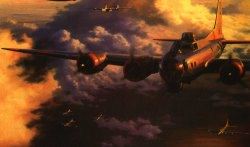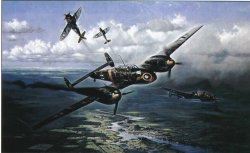| |
Two months later the Mustangs would have made a difference. Four months later there would have been four P-51B groups with men like Don Blakeslee, Glen Eagleston and Don Gentile to watch out for their Big Friends. The carnage would have never happened.
But on October 14, 1943 when the 103 P-47s turned back near Aachen, the Luftwaffe fighters pounced like lions on the B-17s sent to bomb Schweinfurt's ball bearing plants.
ROUND & HARD
To put it concisely, every piece of war machinery from a search light or 88mm gun to a fighter or bomber aircraft used ball bearings, at a rate of 2.5 million per month. The strategic concept was to lessen then destroy the vital production of ball bearings so that the hardware of conflict could not be manufactured.
Similarly, attacking fuel production facilities was another way to hinder Germany's ability to wage war. Schweinfurt contributed 45% of the nation's bearings from its vast complex of production accommodations.
An August attack on Schweinfurt had lost 36 bombers. The early days of October leading up to the raid showed mounting losses of heavies as increasing numbers plied the skies to German targets.
THE LUFTWAFFE
It would have been a combat flight simulator hobbyist's dream to see so many types of planes in vast numbers. For the men in the B-17s it proved a nightmare.
Virtually every type of combat aircraft intercepted the American force once the Thunderbolts were forced to return home due to minimal fuel status. The P-47s did break up many attacks and accounted for 13 German planes before sorrowfully winging west. Once the Little Friends were gone it must have looked like a Luftwaffe recognition book to the crewmen on the bombers. Bf 109Gs, FW 190s, Me 110s & 210s, six cannoned JU 88s, Do 217s and even rocket lugging He111 attacked.
Green kids in feeble He113s were airborne with the likes of He 177s while huge FW 200s trailed the Fortresses giving position to incoming comrades. Even JU 87 Stukas were seen by the startled airmen at 22,000 feet altitude. FW 189s, usually used in ground support, swept against the Forts too. Beyond that, the color array of aircraft was astounding in its variety as well. The paint shop show soon took on a macabre, Dali surrealness as the slaughter commenced.
LOST LIBS
Sixty B-24Ds were to be part of the attack force but the heavy clouds made it impossible, once airborne, to join up with the B-17Es and "Fs". Only 29 assembled. The plan was for attack on a secondary target if that occurred. With 56 P-47 Thunderbolt escorts the Liberators performed their diversion attack on Emden without losses. The original plan for Mission 115 called for 383 heavy bombers. Now at the onset there were sixty less.

B17sa by Robert Taylor
The bomb group assembled, the difficulty of maintaining position and speed relative to the leader, Colonel Budd Peaslee, began. So began the concert of twiddling throttles to keep in the 130 to 190 m.p.h. range.
Click to continue
|
|

Me 110s and P47s. Artwork by Heinz Krebs.
Height position in relation to other B-17s was crucial to keep fire coverage in the box formation. Pilots were constantly moving throttles to speed up or kicking rudders left and right to slow down then moving the control column to gain or lose height. All this became infinitely more difficult once the Germans attacked. Eighteen big bombers made a box and it was roughly a 750 foot cube of aircraft.
INTO THE FIRE
It was figured that about 300 German fighters were along the path of the bombers. Actually, in the summer of 1943 many squadrons were recalled from other fronts to defend the Reich proper. The force consisted of 600 Bf 109 and FW 190 single-engined fighters and nearly 200 twin-engined day fighter destroyers. Many of these planes and pilots flew a second sortie that day.
The fighters assembled to take on heavy bombers were heavily armed. Extra armor and armament was the order of the day. These planes didn't come to dogfight; they came to transfer as much ballistic power as possible from their guns into the B-17s to bring them down. There were many rocket-carrying twin-engined planes mounting the huge 21 cm. projectiles.
They lobbed the rockets from both sides and from the back of the formations from 1,500 yards as the 109s and 190s bore in from head on. From the time the P-47s broke off near Aachen leaving the Big Friends to their fate, the Germans attacked. But as they neared the target the Germans began concentrating on one formation at a time and fired from very close range for effectiveness.
There were Bf 109s with bright orange noses and the rest of the plane black. Some 190s were painted yellow all over. 110s had big yellow patches on the bellies. The Ju 88s had multi-colored striped tops with white bellies. Other 88s were solid black over white undersides. More 109s were noted all silver with green noses. The Fw 200s were all silver and 190s were seen with yellow nose and green cowls. Attacking He 177s were black and white; one would think Göering himself was in the paint shops.
But as surreal as it seemed to the defenders, the 20mm rounds were real enough as fifty to sixty fighters at a time from groups of an ongoing gaggle of 300 closed to ramming distance to fire. A large flight of Me 210s closed to 500 yards and released rockets. B-17 crews said the rocket bursts were as powerful as the 88mm flak explosions from the guns four miles below.
Some were even larger. Huge flashes from high caliber cannon mounted on twin-engined attackers were noted. FW 200s and Bf 109s flying above the formations dropped air to air bombs which exploded differently depending on the type- incendiary, fragmentary or bright high explosive.
And most strange of all, four aircraft were positively identified as P-47s near the B-17s. They were painted a very dark brown and had no Allied white stripe markings or insignia. They were fired on since the last P-47 escorts left long ago. They were captured aircraft!
Go to Part II: the Sargent's Defense
|
|


